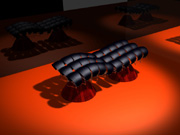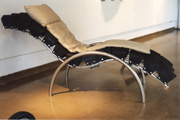
Computer rendering of
preliminary design (above) and finished chaise longue (below), integrating
an ecological approach using recycled tires. Designed and built by Design
Art student, Marco Turchetta, it received the 2000 SIDIM Eco Design
Award, and orders from Quebec and the U.K.

Images courtesy of Lydia Sharman
|
by
Debbie Hum
A new graduate certificate program starting this fall will allow students
from interdisciplinary backgrounds to explore the impact and possibilities
of digital technologies in the practice of design.
The one-year, 15-credit program will combine the use of digital technologies
as a tool in the design art process, with an advanced investigation of
their economic, social and cultural consequences. Students in the program
will have access to a three-dimensional scanner and to computer-assisted
prototyping equipment, both instruments that are changing development
in product design.
“New opportunities are being afforded designers with the convergence
of various kinds of media in the world of the digital,” said Michael
Longford, assistant professor in Design Art. Longford, with Lydia Sharman,
chair of Design Art, and Assistant Professor P.K. Langshaw, developed
the certificate program, Digital Technologies in Design Art Practice,
over the past year.
While digital technologies have been an integrated part of the design
art curriculum for more than 12 years, this will be the first graduate
certificate that Concordia offers in the studio area. It is considered
unique in Canada for its combination of experimental and applied approaches
to two- and three-dimensional design and digital media design.
In addition to three seminar courses, students will undertake individual
research projects. These will explore the relevance of digital technologies
in one or two of the following areas: print media, 3D object, interactive
media, hybrid practice, and theoretical studies.
The program is conceived as a way of responding to the challenges that
digital technologies present to the designer. In addition to recent graduates,
it is expected to draw professionals who are already working in the ever-expanding
digital field, including people with computer science backgrounds who
want to integrate design into their work.
“In industry, the notion of a sabbatical is becoming more popular,”
Longford remarked. In an age when professionals have to constantly update
their learning and knowledge, more people are contemplating a year away
from work to explore digital venues in a more concentrated way, develop
skills they can bring back to their jobs, or even shift their career paths,
he added.
The program accommodates working professionals by offering courses on
Thursday evenings and Friday afternoons, and weekend access to computer
labs.
In just 10 years, digital technologies have had an enormous impact on
design. In the Visual Arts Building, state-of-the-art computer labs reside
next to workshops in which traditional approaches to design, such as maquette
building, are still used. A new rapid prototyping machine, sometimes called
a “3-D printer,” will continue the technological revolution
in product design by enabling designers to render their 3-D digital creations
into objects.
Dr. Sharman emphasized the importance of generating discourse and pedagogy
on the impact, ethics and social responsibilities surrounding digital
technologies. The reading seminar “Language, Politics, Manifestos,”
for example, will consider issues on design ecology and ethics, gender
polarization and biases, and political strategies in the public sphere.
The launch of the new program will coincide with an international symposium
held at Concordia in the fall, called “Declarations of [Inter]dependence
and the Im[media]cy of Design.”
The deadline for applications to the certificate program is April 18.
Application forms can be picked up at the School for Graduate Studies,
the Department of Design Art, or through the design art Web site, http://design.concordia.ca/.
|
|
|



